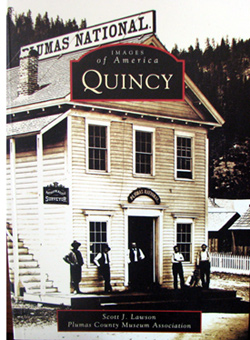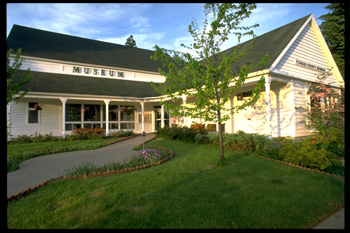
Historical Quincy
QHS Music History | Origin of Highway 70
Reproduced with permission by Scott Lawson

Quincy, California, is a picturesque community of some 5,500 people nestled into the south side of the American Valley in central Plumas County. Surrounded by timber-clad hillsides and snow capped peaks, its nickname, "The Gem of the Sierras," is a fitting description.
In June of 1850 the Turner brothers claimed all the land south of Spanish Creek that now encompasses Quincy. They supported, in spirit, if not in cash, mountain man Jim Beckwourth's efforts to bring an emigrant wagon road through the valley on its way from the Nevada desert to the Sacramento Valley. Even without their financial support Beckwourth's Trail did result in some parties staying and establishing homes in the American Valley. Among them were Lewis Stark and others who were instrumental in discovering the rich gold placers at Elizabethtown in the fall of 1852. Hugh J. Bradley purchased land from the Turners in the summer of 1852 and established a stopping place called the American Ranch, which name the small community became known by for a time. Farmers began taking up ranches, and soon, the first sawmill, gristmill, and blacksmith shop were established in the valley.
Although the small community of American Ranch was already established, it is generally accepted that Quincy proper made its debut with the birth of the county in 1854. On March 18th 1854, an act was passed by the State of California creating Plumas County from the eastern portion of Butte County. John Thompson, Wilson Seaman Dean, and Hugh J. Bradley were appointed commissioners to set up the elections for county officers and a county seat. At this point, the spirited gold camp of Elizabethtown developed the notion it should become the county seat. However, its canyon-like location was inferior to that of the more expansive American Valley. Bradley's offer to donate land for a courthouse in exchange for the county seat and the name of Quincy, after his hometown in Illinois, was accepted by the county's voters. American Ranch, was renamed Quincy, and designated the county seat.
Of course all of this ignored the original inhabitants of the American Valley, the Maidu Indians, who had lived in the valley for centuries before the white man came. Forced from their ancestral homes along the valley's southern exposure by agricultural development, many attached themselves to the new ranches and became domestic servants and ranch hands.
Until recently, emigration to Quincy was based on mostly economic factors. As Plumas County's gold mines prospered, many miners, including great numbers of Chinese moved into the area. Since then, the Chinese have largely disappeared; when the gold gave out most went elsewhere. A few remained, but for the most part, all that is left is a Chinese cemetery, place names, and the remains of the roads, ditches, and other projects they helped build. Roads and communication lines developed; first telegraph, then the telephone, linked Quincy to the outside. During the 1870s the area was in full economic boom as the gold poured from the hydraulic mines. Come the turn of the century, for various reasons gold mining was starting to decline and the timber industry was beginning an upward swing. In 1910, the newly completed Western Pacific Railroad connected Quincy with the rest of the world economically. With gold and copper mining still a viable revenue source, the timber industry's rapidly increasing development, and agriculture's steady output, turn of the 20th century Quincy looked better than it ever had economically. A sawmill sprang up where today's Plumas Pines Shopping Center is located. During the late 1930s and into the 1950s, mill owner C.A. King brought a large number of African-Americans from Lake Charles, Louisiana to Quincy to work in the mill. Although the mill closed many years ago, many of King's employees remained, raising their families, attending local schools, and becoming a part of the community.
Quincy's Main Street, laid out in an east-west fashion, developed a business section that clustered near the county square. A collection of log and other rustic buildings first sprang up, but with the new courthouse and community pride, more handsome buildings replaced the early structures. These too were modified as time marched along; fires took their toll, new owners wanted a new look, more substantial structures were erected, but for the most part the business section maintained its original flavor. A catastrophic fire in August 1934 leveled many of the original wooden business structures, but a few of the early buildings still remain to this day, recognizable, though there are some changes from their original appearance. In 1921 a new courthouse was completed to replace the 1859 structure that had served the county for over 60 years. In 1937, the Feather River Highway was completed, allowing easier auto travel to and from the county seat.
Since Quincy's inception, three hotels have come and gone on the site of the new Dame Shirley Plaza; numerous buildings on Main Street have been replaced by fire, economics, and time, and scores of attractive homes built, particularly along historic Jackson Street. Growth has occurred in all directions, but particularly in East Quincy, originally a collection of ranches, and later and a few business establishments, such as the Stone House. During the 1950s, a business strip development along Highway 70 took place and south of it, housing developments notably Amervale, were built. Scores of new businesses, the county fairgrounds, a new high school, new grammar schools, and a community college have been built as well. Long touted as one of the only counties in the state left without a stoplight, that also changed about fifteen years ago. For all its existence, Quincy's economy has relied on natural resources, particularly the timber industry. Due to various factors, a large reduction in that sector has seen a greater dependence on the tourism industry. Visitors now come to enjoy the county's outdoor recreation opportunities, as well as Quincy's cultural and historical amenities.
Today, a small group of dedicated people that love Quincy's history still endeavor to protect Quincy's historic areas for the enjoyment, and edification not only of today's residents, but also for those generations of residents and visitors to come.
~ Scott Lawson

Plumas County Museum
The Origin of Highway 70
Route 87 from Woodland to Oroville and Route 21 from Oroville to east of Beckwourth Pass became a new State Route 24 in 1934; State Route 24 was extended southwest from Woodland to Oakland by the end of 1937. In 1954, the original part of State Route 24 was replaced by U.S. Route 40 Alternate, which continued south on U.S. 99W from Woodland to Davis and southeast on U.S. 395 to Reno, Nevada to join U.S. 40 at both ends. A direct route from Marysville south to Sacramento was added to the state highway system in 1949 as Route 232, and later became part of a rerouted State Route 24. The U.S. 40 Alternate designation was short-lived, and was mostly replaced by State Route 70 in the 1964 renumbering.
Copyright © 2007–; All Rights Reserved.